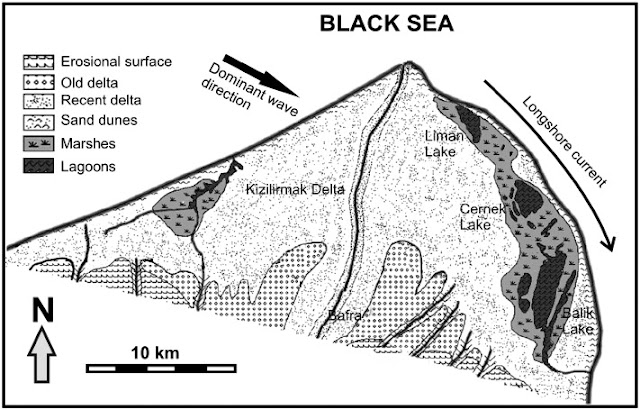Volcanoes in Turkey
How do Volcanoes Work?
Before we begin discussing volcanoes, here is a short video clip with Dr. Liz Cottrell, of the Smithsonian Institution's National Museum of Natural History. She talks about what causes a volcano to erupt and demonstrates the principle behind the eruption:
https://www.youtube.com/watch?v=6BGd79g1tms
Turkey: Rich in Volcanoes
Turkey ranked 14th, in an assessment of overall volcanic threat, out of 95 volcanically active countries, reflecting high population exposure. Turkey is vulnerable to volcanic hazards due to the large exposed population, lack of experience of public officials and communities with volcanic emergencies, very limited volcano monitoring, and lack of knowledge on volcanic hazards and risk.
Examples of different types of volcanoes in Turkey
Mt. Ararat – Stratovolcano
Last eruption –
1840 CE
The 5165-m-high, double-peaked
stratovolcano Mount Ararat, also known as Agri Dagi, is Turkey's highest,
largest volume, and easternmost volcano. Glacier-clad Ararat, along with its
twin volcano, 3925-m-high Kucuk Ararat (or Lesser Ararat), covers an area of
1000 sq km.
Kula –
Pyroclastic cone(s)
Last eruption
- unknown
Nemrut Dagi –
Stratovolcano
Last known
eruption – 1650 CE
(I thought this was an excellent aerial shot of the cone.)
Overview of Volcanoes in Turkey - slideshow
Developing an Early Warning System
Geological and historical records of the
ten active volcanoes in Turkey all show potential for major
explosive eruptions. Over 4 million people live within 30 km of an active
volcano, and over 15 million live within 100 km.
Turkey is vulnerable to volcanic hazards due to the large exposed population, lack of experience of public officials and communities with volcanic emergencies, extremely limited volcano monitoring, and lack of knowledge on volcanic hazards and risk.
However, there is an exciting new research project just getting underway in early 2018, through a grant from the Research Councils of the UK. This grant-funded project aims to assist Turkish officials with development of appropriate volcanic
emergency management plans and disaster risk reduction. The project will identify high-risk volcanoes; develop new methods for identifying vulnerable populations and
population exposure; and identify critical infrastructure.
The proposal calls for increased monitoring capacity in Turkey through purchase and installation of crucial
monitoring equipment at a high-risk volcano. Training in monitoring techniques,
interpretation of the monitoring signals, and satellite data will be used, along with enhanced education for the local
communities, scientists, authorities and emergency managers.
The grant will partner with Turkish officials so they can learn from those with direct experience of volcanic
emergencies in order to build preparedness, thus implementing early warning systems along the most active volcanoes and having the potential for saving tens of thousands of lives.
Harnessing Geothermal Energy
A positive impact of the proliferation of volcanoes in Turkey, is that Turkey has an abundance of geothermal energy, derived from the Earth's internal heat. Turkey began its geothermal energy program in the 1970s. This later grew into a pilot facility, which later became Turkey's first power plant in the 1980s. Today, Turkey is the 7th richest country in the world, in terms of geothermal potential.
REFERENCES
Blumenthal M M, van der Kaaden
G, Vlodavetz V I, 1964. Turkey & Caucasus. Catalog of Active Volcanoes of
the World and Solfatara Fields, Rome: IAVCEI, 17: 1-23.
Pearce J A, Bender J F, de
Long S E, Kidd W S F, Low P J, Guner Y, Saroglu F, Yilmaz Y, Moorbath S,
Mitchell J G, 1990. Genesis of collision volcanism in eastern Anatolia, Turkey. J. Volcanol. Geotherm. Res., 44: 184-229.
Smithsonian
Institution, National Museum of Natural History, Global Volcanism Program.
National
Environmental Research Council
Research
Councils of the UK






Hi Linda,
ReplyDeleteYour post is so thorough and well-researched! I learned so much about Turkey's relation to volcanic activity. I honestly don't know much about Turkey's geography, so I was surprised to learn that Turkey has so many active volcanoes! You found such excellent pictures of a couple of those volcanoes, especially the cone of the Nemrut Dagi.
It's frightening to think that so many people in Turkey live so close to an active volcano, and yet there is no real warning or education system in place yet. That's why it's so great to hear that Turkey is taking a step forward in this aspect with the grant from the UK this year. Hopefully many lives can be saved in the future with the development of this new volcano monitoring program.
Incredible to know that Turkey has so much geothermal energy within its borders. It's great to hear that that they are taking advantage of that kind of renewable energy with the power plants that harness it.
I appreciate the videos and pictures you included. Thank you for sharing this very insightful post!